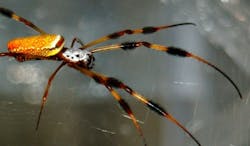ASU scientists use Brillouin scattering to measure mechanical properties of spider silk
Glendale, AZ--Scientists at Arizona State University (ASU) have used Brillouin light scattering to noninvasively determine the complete mechanical elastic response of spider webs—important data that has been missing for researchers who want to create artificial materials with the extensibility and tensile strength of natural spider webbing.1 The linear elastic response was measured for all possible deformation modes—data that is impossible to get using traditional stress–strain tests.
Noncontact technique
The Brillouin scattering technique used an extremely low power laser (less than 3.5 mW). Recording frequency shifts in the light scattered through intact spider webs enabled the researchers to spatially map the elastic stiffnesses of each web without deforming or disrupting it. This noninvasive, non-contact measurement produced findings showing variations among discrete fibers, junctions, and glue spots.
Four different types of spider webs were studied. They included Nephila clavipes (pictured), A. aurantia (“gilded silver face”—common to the contiguous United States), L. Hesperus (the western black widow) and P. viridans (the green lynx spider, and the only spider included that does not build a web for catching prey but has major silk elastic properties similar to those of the other species studied).
The group also investigated one of the most studied aspects of orb-weaving dragline spider silk, namely supercontraction, a property unique to silk. Spider silk takes up water when exposed to high humidity. Absorbed water leads to shrinkage in an unrestrained fiber up to 50% shrinkage with 100% humidity in N. clavipes silk.
Their results are consistent with the hypothesis that supercontraction helps the spider tailor the properties of the silk during spinning. This type of behavior, specifically adjusting mechanical properties by simply adjusting water content, is inspirational from a bio-inspired mechanical structure perspective.
“This study is unique in that we can extract all the elastic properties of spider silk that cannot and have not been measured with conventional testing,” concluded Yarger.
REFERENCE:
1. Kristie J. Koski et al., Nature Materials (2013) doi:10.1038/nmat3549

John Wallace | Senior Technical Editor (1998-2022)
John Wallace was with Laser Focus World for nearly 25 years, retiring in late June 2022. He obtained a bachelor's degree in mechanical engineering and physics at Rutgers University and a master's in optical engineering at the University of Rochester. Before becoming an editor, John worked as an engineer at RCA, Exxon, Eastman Kodak, and GCA Corporation.
